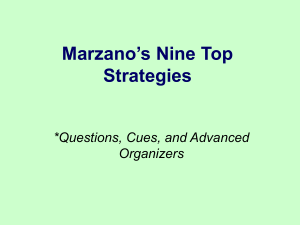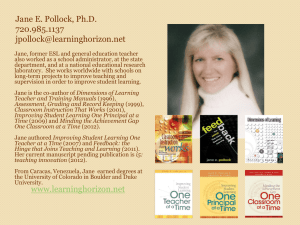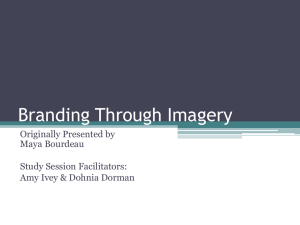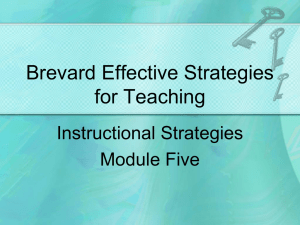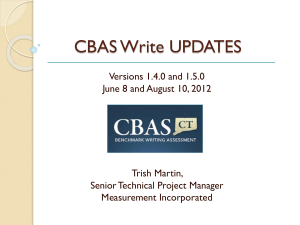Cues, Questions, and Advance Organizers
advertisement
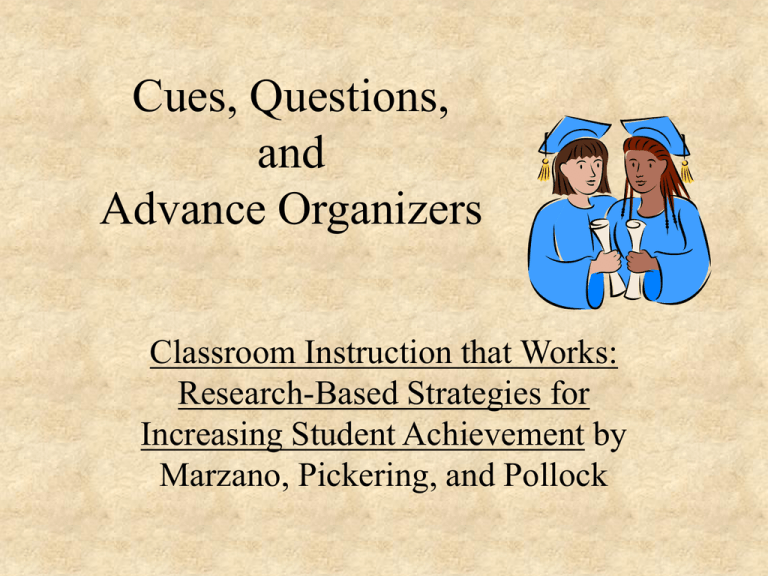
Cues, Questions, and Advance Organizers Classroom Instruction that Works: Research-Based Strategies for Increasing Student Achievement by Marzano, Pickering, and Pollock Review HYIS • Frayer Activity • What strategies are you using in core? With your intervention students (tier 2)? With the other students while you are working with your intervention students? Video…. Cues, Questions, and Advanced Organizers…… • Before learning new information, teachers should help students retrieve what they already know about a topic or “activate prior knowledge.” • The activation of prior knowledge is critical to learning because it helps students understand new information, predict what might be coming, and clarify misconceptions. • Cues, questions, and advance organizers are three common ways that a classroom teacher helps students use what they already know about a topic. Research Results: Cues and Questions Name of Study Focus # of Effect Studies Percentile Gain Cues 6 16 Walberg, 1999 Questions 14 10 Redfield and Rousseau, 1981 Questions 7 28 Wise and Okey, 1883 Questions 5 14 Cues 38 20 Stone, 1983 Cues 83 27 Bloom, 1976 Cues 11 39 Crismore, 1985 Cues 231 23 Hamaker, 1986 Questions 100 27 Guzzetti, Snyder, and Glass, 1993 Questions and Cues 11 29 Ross, 1988 The Research • Teachers form 6 groups • Each group reads the research about one of the 6 strategies: cues, questions, expository advance organizer, narrative advance organizer, skimming as an advance organizer, and graphic organizers presented in advance • Each group presents their research on a poster (definition, examples, non-linguistic) • Use the graphic organizer to take notes Cues • Cues involve “hints” about what the students are about to experience. • Cues and questions should focus on what is important as opposed to what is unusual. • Use Explicit Cues: – – – – Preview of what students are about to learn Activates prior knowledge Should be straightforward Teacher can elicit from students what they already know about a topic. ***Classroom Examples? Questions • Questions perform the same function as cues. • The teacher may write a list of questions on the board to provide a focus for learning new information. 1. Should focus on what is important not unusualCues and questions should focus on what is important as opposed to what is unusual 2. Use Bloom’s: “Higher level” questions produce deeper learning than “lower level” questions 3. Increasing wait time increases depth of answers 4. Questions are an effective tool even before a learning experience ***Classroom Examples? Advance Organizers An organizational framework teachers can present to students prior to teaching new content to prepare them for what they are about to learn. Advance organizers take the surprise out of what is to come, help students retrieve what they already know about a topic, and focus them on new information. Students are able to see the connections and/or the relationship between pieces of information. Expository Advance Organizers • An expository advance organizer may simply provide students with the meaning and purpose of what is to follow. • On the other hand an expository organizer may present students with more detailed information of what they will be learning especially the information that may be difficult to understand. ***Classroom Examples? Narrative Advance Organizers -A narrative advance organizer takes the form of a story. Here the teacher provides the essential ideas of a lesson or unit she plans to teach by telling a story that incorporates the ideas. -Stories can make something distant or unfamiliar seem personal and familiar. -Stories can stimulate students’ thinking and help them make personal connections to new information ***Classroom Examples? Skimming as a Graphic Organizer – When a teacher asks students to skim learning materials, he/she provides them with the opportunity to preview the important information that will encounter later by focusing on and noting what stands out in headings, subheadings, and highlighted information. -Preview important information quickly by noting what stands out in headings and highlighted information -Pre-reading questions or SQ3R (survey, question, read, recite, review) can be helpful before skimming ***Classroom Examples? Graphic Organizers Presented in Advance • Graphic organizers also provide students with guidance on what the important information is in a lesson or unit. • They visually represent information students are about to learn. • They give students direction and also provide a visual representing of the important information. • It is easy to see what is important and the relationships between the ideas and patterns in the information where they exist. ***Classroom Examples? In Conclusion • Before learning new information, teachers should help students retrieve what they already know about a topic or “activate prior knowledge.” • Cues, questions, and advance organizers are three common ways that a classroom teacher helps students use what they already know about a topic to learn new information. • Cues give hints of what is to be learned. • Analytical and inferential questions asked of students before learning help fill-in the gaps and provide a focus for learning. • Narrative advance organizers, expository advance organizers, skimming, and graphic organizers help students focus on important information by providing a mental set. WORKTIME • Go to tech4hyis.pbworks.com • Use the handout to find specific strategies you can use with your students (in core or tier 2) • Record your next steps and how Kiser can help you (turn in to Kiser!)

